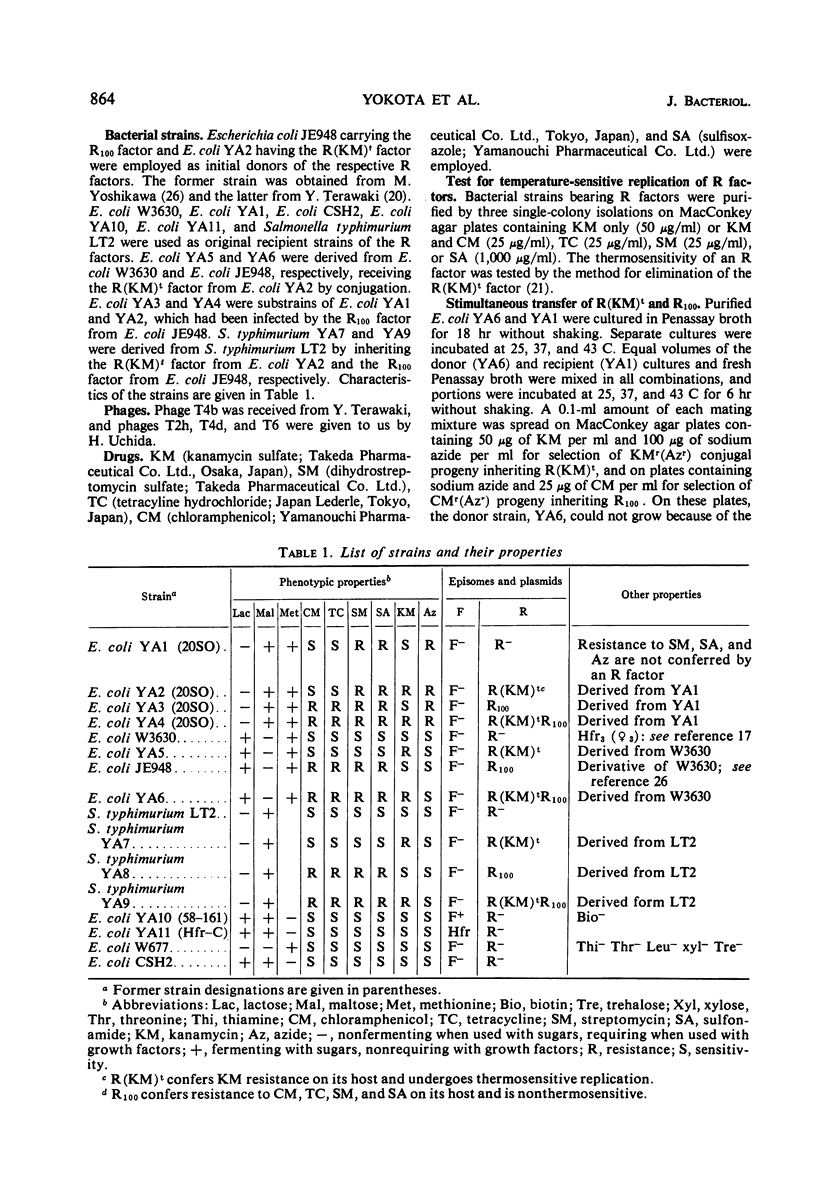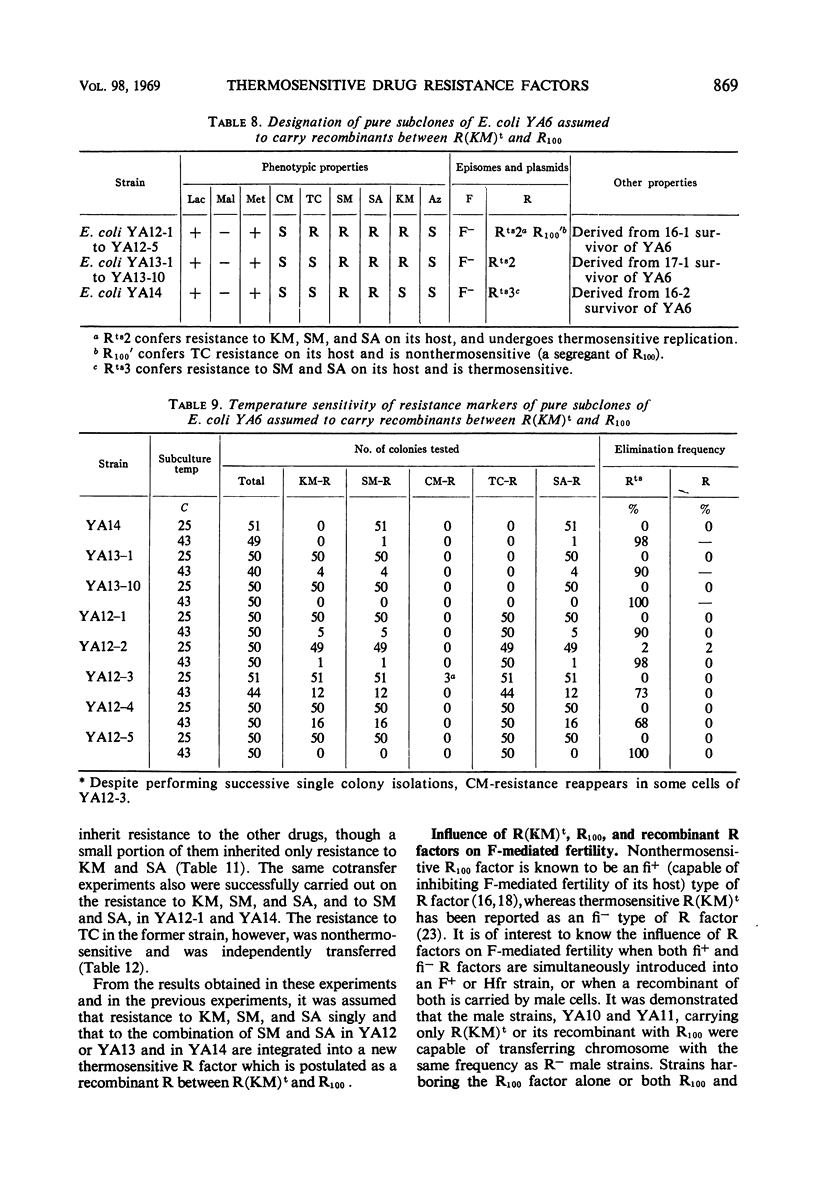Abstract
The thermosensitive kanamycin (KM) resistance factor, R(KM)t, and a nonthermosensitive multiple-drug resistance factor, R100, were simultaneously introduced into Escherichia coli and Salmonella typhimurium. The temperature sensitivity of both R factors remained unchanged as long as they replicated independently. Under certain conditions, however, a new thermosensitive R factor harboring resistance markers for kanamycin, streptomycin (SM), and sulfanilamide (SA) was obtained by recombination between the R(KM)t and R100 factors. R factors carrying resistance markers for KM and SA, or for SM and SA, were obtained from the recombinant R(KM SA SM)t by spontaneous segregation. Though the R100 factor has been known as an fi+ (positive for F-mediated fertility inhibition of its host) type and it does not restrict any coexisting phages, the thermosensitive recombinants of R100 with R(KM)t and their segregants were found to be fi− and to restrict the replication of all T-even phages, as does the R(KM)t factor. Double infection immunity was not observed between the R(KM)t and R100 factors.
Full text
PDF










Selected References
These references are in PubMed. This may not be the complete list of references from this article.
- AKIBA T., KOYAMA K., ISHIKI Y., KIMURA S., FUKUSHIMA T. On the mechanism of the development of multiple-drug-resistant clones of Shigella. Jpn J Microbiol. 1960 Apr;4:219–227. doi: 10.1111/j.1348-0421.1960.tb00170.x. [DOI] [PubMed] [Google Scholar]
- ANDERSON E. S., DATTA N. RESISTANCE TO PENICILLINS AND ITS TRANSFER IN ENTEROBACTERIACEAE. Lancet. 1965 Feb 20;1(7382):407–409. doi: 10.1016/s0140-6736(65)90004-8. [DOI] [PubMed] [Google Scholar]
- Abe H., Goto S., Kuwahara S. [Transmission, by conjugation, of multiple drug-resistance from Shigella to Aeromonas and non-agglutinable Vibrio]. Nihon Saikingaku Zasshi. 1966 May;21(5):266–273. doi: 10.3412/jsb.21.266. [DOI] [PubMed] [Google Scholar]
- Benzer S. FINE STRUCTURE OF A GENETIC REGION IN BACTERIOPHAGE. Proc Natl Acad Sci U S A. 1955 Jun 15;41(6):344–354. doi: 10.1073/pnas.41.6.344. [DOI] [PMC free article] [PubMed] [Google Scholar]
- Cuzin F., Jacob F. Association stable de deux épisomes F différents dans un clone d'Escherichia coli. Ann Inst Pasteur (Paris) 1967 Aug;113(2):145–155. [PubMed] [Google Scholar]
- Echols H. PROPERTIES OF F' STRAINS OF ESCHERICHIA COLI SUPERINFECTED WITH F-LACTOSE AND F-GALATOSE EPISOMES. J Bacteriol. 1963 Feb;85(2):262–268. doi: 10.1128/jb.85.2.262-268.1963. [DOI] [PMC free article] [PubMed] [Google Scholar]
- GINOZA H. S., MATNEY T. S. TRANSMISSION OF A RESISTANCE TRANSFER FACTOR FROM ESCHERICHIA COLI TO 2 SPECIES OF PASTEURELLA. J Bacteriol. 1963 May;85:1177–1178. doi: 10.1128/jb.85.5.1177-1178.1963. [DOI] [PMC free article] [PubMed] [Google Scholar]
- JACOB F., BRENNER S. [On the regulation of DNA synthesis in bacteria: the hypothesis of the replicon]. C R Hebd Seances Acad Sci. 1963 Jan 2;256:298–300. [PubMed] [Google Scholar]
- KUWABARA S., AKIBA T., KOYAMA K., ARAI T. TRANSMISSION OF MULTIPLE DRUG-RESISTANCE FROM SHIGELLA FLEXNERI TO VIBRIO COMMA THROUGH CONJUGATION. Jpn J Microbiol. 1963 Aug;7:61–67. doi: 10.1111/j.1348-0421.1963.tb00243.x. [DOI] [PubMed] [Google Scholar]
- Mise K., Suzuki Y. Temperature-sensitive chloramphenicol acetyltransferase from Escherichia coli carrying mutant R factors. J Bacteriol. 1968 Jun;95(6):2124–2130. doi: 10.1128/jb.95.6.2124-2130.1968. [DOI] [PMC free article] [PubMed] [Google Scholar]
- NAKAYA R., NAKAMURA A., MURATA Y. Resistance transfer agents in Shigella. Biochem Biophys Res Commun. 1960 Dec;3:654–659. doi: 10.1016/0006-291x(60)90081-4. [DOI] [PubMed] [Google Scholar]
- SUGINO Y., HIROTA Y. Conjugal fertility associated with resistance factor R in Escherichia coli. J Bacteriol. 1962 Nov;84:902–910. doi: 10.1128/jb.84.5.902-910.1962. [DOI] [PMC free article] [PubMed] [Google Scholar]
- Terawaki Y., Kakizawa Y., Takayasu H., Yoshikawa M. Temperature sensitivity of cell growth in Escherichia coli associated with the temperature sensitive R(KM) factor. Nature. 1968 Jul 20;219(5151):284–285. doi: 10.1038/219284a0. [DOI] [PubMed] [Google Scholar]
- Terawaki Y., Takayasu H., Akiba T. Thermosensitive replication of a kanamycin resistance factor. J Bacteriol. 1967 Sep;94(3):687–690. doi: 10.1128/jb.94.3.687-690.1967. [DOI] [PMC free article] [PubMed] [Google Scholar]
- Terawaki Y. [The R factor of multiple drug-resistant Cloaca isolated from the urine]. Igaku To Seibutsugaku. 1965 Oct 10;71(4):217–221. [PubMed] [Google Scholar]
- Yoshikawa M., Sevag M. G. Sensitivity of Escherichia coli to atabrine conferred by R factor and its potential clinical significance. J Bacteriol. 1967 Jan;93(1):245–253. doi: 10.1128/jb.93.1.245-253.1967. [DOI] [PMC free article] [PubMed] [Google Scholar]


